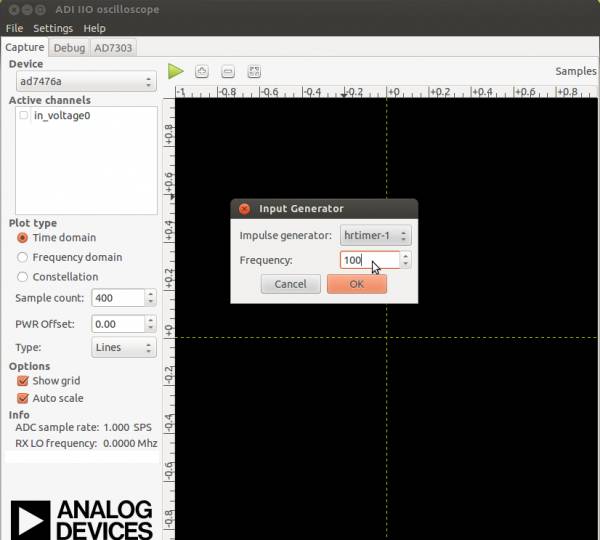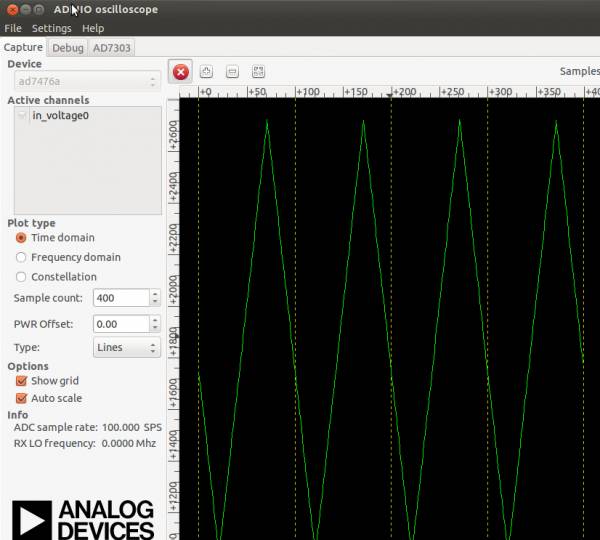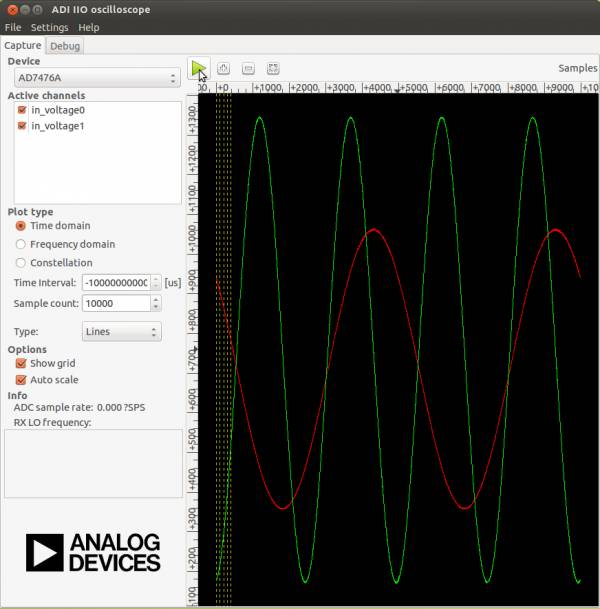
The AD7476A is 12-bit, high speed, low power, successive-approximation analog-to-digital converter (ADC). The part operates from a single 2.35V to 5.25V power supply and feature throughput rates up to 1 MSPS. The part contains a low noise, wide bandwidth track-and-hold amplifier that can handle input frequencies in excess of 13 MHz.
Two reference designs are available for this part:
The bit file provided in the project *.zip file combines the FPGA bit file and the SDK elf files. It may be used for a quick check on the system. All you need is the hardware and a PC running a UART terminal and the programmer (IMPACT).
If you are not familiar with LX9 and/or Xilix tools, please visit
products/boards-and-kits/AES-S6MB-LX9.htm for details.
If you are not familiar with Nexys™3 and/or Xilix tools, please visit
http://www.digilentinc.com/Products/Detail.cfm?NavPath=2,400,897&Prod=NEXYS3 for details.
If you are not familiar with ZedBoard and/or Xilix tools, please visit
http://www.em.avnet.com/en-us/design/drc/Pages/Zedboard.aspx for details.
Extract the project from the archive file (AD7476A_<board_name>.zip) to the location you desire.
To begin, connect the PmodAD1 to J5 connector of LX9 board (see image below). You can use an extension cable for ease of use. Connect the USB cable from the PC to the USB-UART female connector of the board for the UART terminal. The board will be programmed through its USB male connector.
Extract the project from the archive file (AD7476A_<board_name>.zip) to the location you desire.
To begin, connect the PmodAD1 to JA connector of NEXYS3 board (see image below). You can use an extension cable for ease of use. Connect the USB cables from the PC to the board, one for programming (Digilent USB device) and one for the UART terminal (FT232R USB UART).
To begin, connect the PmodAD1 to JD connector of ZedBoard (see image below). You can use an extension cable for ease of use. Connect the USB cables from the PC to the board, one for programming (Digilent USB device) and one for the UART terminal (FT232R USB UART).
Start IMPACT, and double click “Boundary Scan”. Right click and select Initialize Chain. The program should recognize the Spartan 6 device (see screenshot below). Start a UART terminal (set to appropiate baud rate) and then program the device using the bit file provided in the project *.zip archive, located in the “sw” folder (../ad7476a/sw/AD7476A.bit).
If programming was successful, you should be seeing messages appear on the terminal window as shown in the figure below. After programming the AD7476A device, the program will automatically read the values of the analog voltage inputs, Vin1 and Vin2, and print them via UART. Pressing any key will initialize another conversion.
Run the download.bat script from the “../bin” folder downloaded from the github (see the links in the download section of the wiki page). The script will automatically configure the ZYNQ SoC and download the *.elf file afterwards.
If the download script fails to run, modify the Xilinx Tools path in download.bat to match your Xilinx Installation path.
If programming was successful, you should be seeing messages appear on the terminal window. After programming the AD7476A device, the program will automatically read the values of the analog voltage inputs, Vin1 and Vin2, and print the raw values via UART.
The reference design is a custom SPI interface, with 2 MISO pins for the AD7476A ICs found on the PmodAD1 (PmodAD1 contains two AD7476A Integrated Circuits, which share the same CS and SCLK pins, but have separate MISO pins). The software programs the device, and afterwards reads the input voltage on both channels and prints them via UART.
The reference design is a custom SPI interface, with 2 MISO pins for the AD7476A ICs found on the PmodAD1 (PmodAD1 contains two AD7476A Integrated Circuits, which share the same CS and SCLK pins, but have separate MISO pins). The software programs the device, and afterwards, using DMA, transfers 8192 samples (4096 for Channel 1 and 4096 for Channel 2) and prints them on the UART.
Avnet LX-9 MicroBoard:
Digilent Nexys™3:
Avnet ZedBoard:
====== Linux Device Driver - Xilinx SPI Core ======
Connect PmodAD1 to the JA1 connector of the ZedBoard (upper row of pins).
===== Preparing the SD Card =====
In order to prepare the SD Card for booting Linux on the ZedBoard:
* Download the device tree: PmodAD1 Linux devicetree
* Follow the instructions on the following wiki page, but use the device tree downloaded on the previous step
* Linux with HDMI video output on the ZED and ZC702.
Make sure you have an HDMI monitor connected to the ZedBoard, plug in the SD Card and power on the board.
If everything is correct, the system should boot up. If you don't have an HDMI monitor, connect to the board via UART, Baud Rate 115200.
There are 2 ways to test the driver.
* Using the terminal window
* Using the ADI IIO Oscilloscope
===== Using the terminal window =====
Open a new terminal window by pressing Ctrl+Alt+T.
Navigate to the location of the device and identify it using the following commands:
<code>
cd /sys/bus/iio/devices/
ls
iio:device0 iio:device1 trigger0
cd iio\:device0
cat name
ad7476a
</code>
If the cat name command doesn't return ad7476a, then change the number of the iio:device, and check again.
<code>
cd ..
cd iio\:device1
cat name
</code>
To see the list of options that the AD7476A driver provides, type:
<code>
ls
buffer in_voltage0_raw name scan_elements trigger
dev in_voltage_scale power subsystem uevent
</code>
To read the raw input voltage, type:
<code>
cat in_voltage0_raw
2156
</code>
To read the scaled input voltage, type:
<code>
cat in_voltage_scale
0.410000
</code>
 The commands written above can also be used if not using an HDMI monitor and a wireless keyboard, by using a serial terminal, and typing the commands after the system boot-up is complete.
The commands written above can also be used if not using an HDMI monitor and a wireless keyboard, by using a serial terminal, and typing the commands after the system boot-up is complete.
 ===== Using the ADI IIO Oscilloscope =====
Install the ADI IIO Oscilloscope using the instructions from the following wiki page:
* IIO Oscilloscope
Launch the ADI IIO Oscilloscope.
Open the Settings menu and select Impulse generator submenu. A popup window will appear and allow you to select an impulse generator (a high resolution timer) and its frequency. The conversions for both the ADC and the DAC are started by the impulses of the generator. Click the OK button.
===== Using the ADI IIO Oscilloscope =====
Install the ADI IIO Oscilloscope using the instructions from the following wiki page:
* IIO Oscilloscope
Launch the ADI IIO Oscilloscope.
Open the Settings menu and select Impulse generator submenu. A popup window will appear and allow you to select an impulse generator (a high resolution timer) and its frequency. The conversions for both the ADC and the DAC are started by the impulses of the generator. Click the OK button.
 Select ad7476a from the Device drop-down menu. Click on in_voltage0 Active channels, and press the Green Play Button. Data will no be dislayed in the main plot window.
Select ad7476a from the Device drop-down menu. Click on in_voltage0 Active channels, and press the Green Play Button. Data will no be dislayed in the main plot window.
 ====== Linux Device Driver - Custom HDL PCore ======
Connect PmodAD1 to the JD1 connector of the ZedBoard (upper row of pins).
===== Preparing the SD Card =====
In order to prepare the SD Card for booting Linux on the ZedBoard:
* Download the device tree: PmodAD1 Linux devicetree
* Download the Xilinx XPS project: PmodAD1 Linux XPS Project
* Download the AD7476A IPcore: AD7476A IPCore
====== Linux Device Driver - Custom HDL PCore ======
Connect PmodAD1 to the JD1 connector of the ZedBoard (upper row of pins).
===== Preparing the SD Card =====
In order to prepare the SD Card for booting Linux on the ZedBoard:
* Download the device tree: PmodAD1 Linux devicetree
* Download the Xilinx XPS project: PmodAD1 Linux XPS Project
* Download the AD7476A IPcore: AD7476A IPCore
* Download the project libraries: Required Project Libraries
* Follow the instructions on the following wiki page, but use the device tree and project downloaded on the previous step
* Linux with HDMI video output on the ZED and ZC702.
Make sure you have an HDMI monitor connected to the ZedBoard, plug in the SD Card and power on the board.
If everything is correct, the system should boot up. If you don't have an HDMI monitor, connect to the board via UART, Baud Rate 115200.
There are 2 ways to test the driver.
* Using the terminal window
* Using the ADI IIO Oscilloscope
===== Using the terminal window =====
Open a new terminal window by pressing Ctrl+Alt+T.
Navigate to the location of the device and identify it using the following commands:
<code>
cd /sys/bus/iio/devices/
ls
iio:device0 trigger0
cd iio\:device0
cat name
AD7476A
</code>
If the cat name command doesn't return ad7476a, then change the number of the iio:device, and check again.
<code>
cd ..
cd iio\:device1
cat name
</code>
To see the list of options that the AD7476A driver provides, type:
<code>
ls
buffer dev name power scan_elements subsystem uevent
</code>
To read the raw input voltage, type:
<code>
cd buffer
echo 100 > length
echo 1 > enable
hexdump -x /dev/iio\:device0
0000000 07f7 07f0 07f7 07ef 07f6 07ef 07f7 07f0
0000010 07f6 07f0 07f5 07ef 07f7 07f0 07f6 07ef
0000020 07f6 07ef 07f7 07f0 07f6 07f0 07f5 07ef
0000030 07f6 07f0 07f6 07f0 07f5 07ef 07f6 07f0
0000040 07f6 07ef 07f6 07ef 07f7 07f0 07f7 07f0
0000050 07f5 07ef 07f6 07f0 07f6 07f0 07f6 07ef
0000060 07f6 07ef
</code>
 The commands written above can also be used if not using an HDMI monitor and a wireless keyboard, by using a serial terminal, and typing the commands after the system boot-up is complete.
The commands written above can also be used if not using an HDMI monitor and a wireless keyboard, by using a serial terminal, and typing the commands after the system boot-up is complete.
 ===== Using the ADI IIO Oscilloscope =====
Install the ADI IIO Oscilloscope using the instructions from the following wiki page:
* IIO Oscilloscope
Launch the ADI IIO Oscilloscope.
Select AD7476A from the Device drop-down menu. Set the desired number of samples in the Sample Count tab. Click the Green Play Button in order to start capturing and displaying data. Click Stop to stop the process.
===== Using the ADI IIO Oscilloscope =====
Install the ADI IIO Oscilloscope using the instructions from the following wiki page:
* IIO Oscilloscope
Launch the ADI IIO Oscilloscope.
Select AD7476A from the Device drop-down menu. Set the desired number of samples in the Sample Count tab. Click the Green Play Button in order to start capturing and displaying data. Click Stop to stop the process.

The bit file provided in the project *.zip file combines the FPGA bit file and the SDK elf files. It may be used for a quick check on the system.
If you are not familiar with Nexys3 and/or Xilix tools, please visit
http://digilentinc.com/Products/Detail.cfm?NavPath=2,400,897&Prod=NEXYS3 for details.
To begin, connect the PmodAD1 to JA1 connector of Nexys3 board, pins 1 to 6 (see image below) and the PmodDA1 to JB1 connector of Nexys3 board, pins 1 to 6. You can use an extension cable for ease of use. Connect the USB cables from the PC to the board.
Start IMPACT, and double click “Boundary Scan”. Right click and select Initialize Chain. The program should recognize the Spartan 6 device (see screenshot below). Program the FPGA using the download.bit file provided in the project *.zip archive, located in the “sw” folder (../ad7303_ad7476/sw/download.bit).
Start the ChipScope Pro Analyzer provided with the Xilinx ISE Design Suite 13.2 and load the project Nexys3_ChipScope_Demo.cpj located in the “chipscope” folder (../ad7303_ad7476/chipscope/Nexys3_ChipScope_Demo.cpj). Click the Open Cable/Search JTAG Chain button and afterwards double click Bus Plot and select Repetitive Trigger Run Mode. Click the Apply Settings and Arm Trigger button. On the main screen you will se the waveforms change once every 25 seconds, between Sine, Square, Sawtooth and Triangle waveforms. Each waveform has a period of 25ms. You can compare the waveform displayed in ChipScope Pro with the waveform displayed on an oscilloscope from the DAC output.